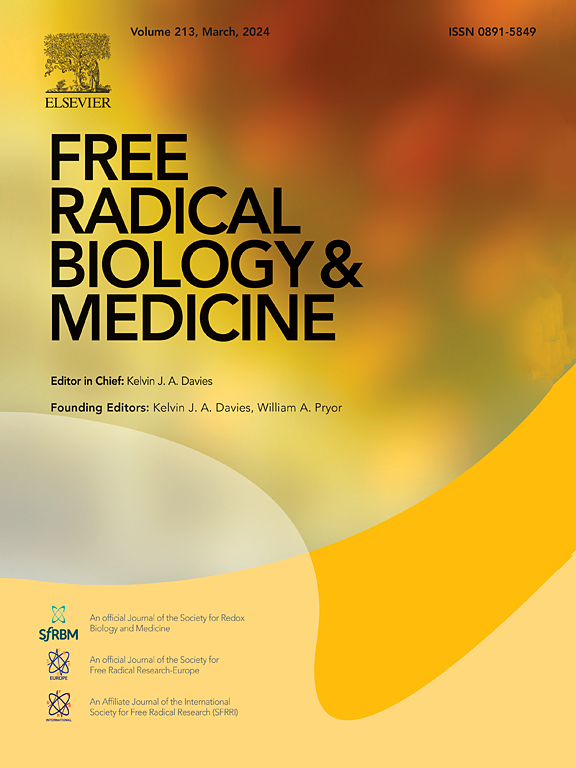膜结构异常介导的铁下垂在dehp诱导的生殖损伤中的作用
IF 7.1
2区 生物学
Q1 BIOCHEMISTRY & MOLECULAR BIOLOGY
引用次数: 0
摘要
邻苯二甲酸二(2-乙基己基)酯(DEHP)是一种常用的增塑剂,已被证明具有生殖毒性;然而,这种效应背后的确切机制尚未完全阐明。本研究旨在探讨青春期前DEHP暴露影响睾丸发育的潜在机制,并提供可能的治疗靶点。我们将BALB/c雄性小鼠从出生后22-35天暴露于不同剂量的DEHP(0、250和500 mg/kg/day)中,并利用脂质代谢组学等方法从多维组织-细胞-分子角度阐明DEHP引起的生殖损伤。我们的研究结果表明,DEHP暴露通过重塑膜脂结构诱导睾丸组织铁下垂,其中磷脂-多不饱和脂肪酸(PL-PUFA)和磷脂-单不饱和脂肪酸(PL-MUFA)失衡起着至关重要的作用。DEHP暴露通过HIPPO和雄激素受体途径改变ACSL4和MBOAT2的表达,从而影响PL-PUFA/PL-MUFA的合成。总之,本研究强调了dehp诱导的生殖损伤与脂质代谢重编程之间的联系,为预防dehp诱导的生殖毒性提供了新的靶点。本文章由计算机程序翻译,如有差异,请以英文原文为准。

Role of ferroptosis mediated by abnormal membrane structure in DEHP-induced reproductive injury
Di-(2-ethylhexyl) phthalate (DEHP), a commonly used plasticizer, has been demonstrated to possess reproductive toxicity; however, the precise mechanisms underlying this effect have yet to be fully elucidated. This study aimed to investigate the potential mechanisms by which prepubertal DEHP exposure impairs testicular development and to provide possible therapeutic targets. We exposed BALB/c male mice from postnatal days 22–35 to different doses of DEHP (0, 250, and 500 mg/kg/day) and utilized lipid metabolomics and other methods to elucidate the reproductive damage caused by DEHP from a multidimensional tissue-cell-molecule perspective. Our findings indicate that DEHP exposure induces ferroptosis in testicular tissue by remodeling membrane lipid structure, in which the imbalance of phospholipid-polyunsaturated fatty acids (PL-PUFA) and phospholipid-monounsaturated fatty acids (PL-MUFA) playing a crucial role. DEHP exposure altered the expression of ACSL4 and MBOAT2 via HIPPO and androgen receptor pathways, thereby impacting PL-PUFA/PL-MUFA synthesis. In conclusion, this study highlights a link between DEHP-induced reproductive damage and lipid metabolism reprogramming, suggesting new targets for preventing DEHP-induced reproductive toxicity.
求助全文
通过发布文献求助,成功后即可免费获取论文全文。
去求助
来源期刊

Free Radical Biology and Medicine
医学-内分泌学与代谢
CiteScore
14.00
自引率
4.10%
发文量
850
审稿时长
22 days
期刊介绍:
Free Radical Biology and Medicine is a leading journal in the field of redox biology, which is the study of the role of reactive oxygen species (ROS) and other oxidizing agents in biological systems. The journal serves as a premier forum for publishing innovative and groundbreaking research that explores the redox biology of health and disease, covering a wide range of topics and disciplines. Free Radical Biology and Medicine also commissions Special Issues that highlight recent advances in both basic and clinical research, with a particular emphasis on the mechanisms underlying altered metabolism and redox signaling. These Special Issues aim to provide a focused platform for the latest research in the field, fostering collaboration and knowledge exchange among researchers and clinicians.
 求助内容:
求助内容: 应助结果提醒方式:
应助结果提醒方式:


